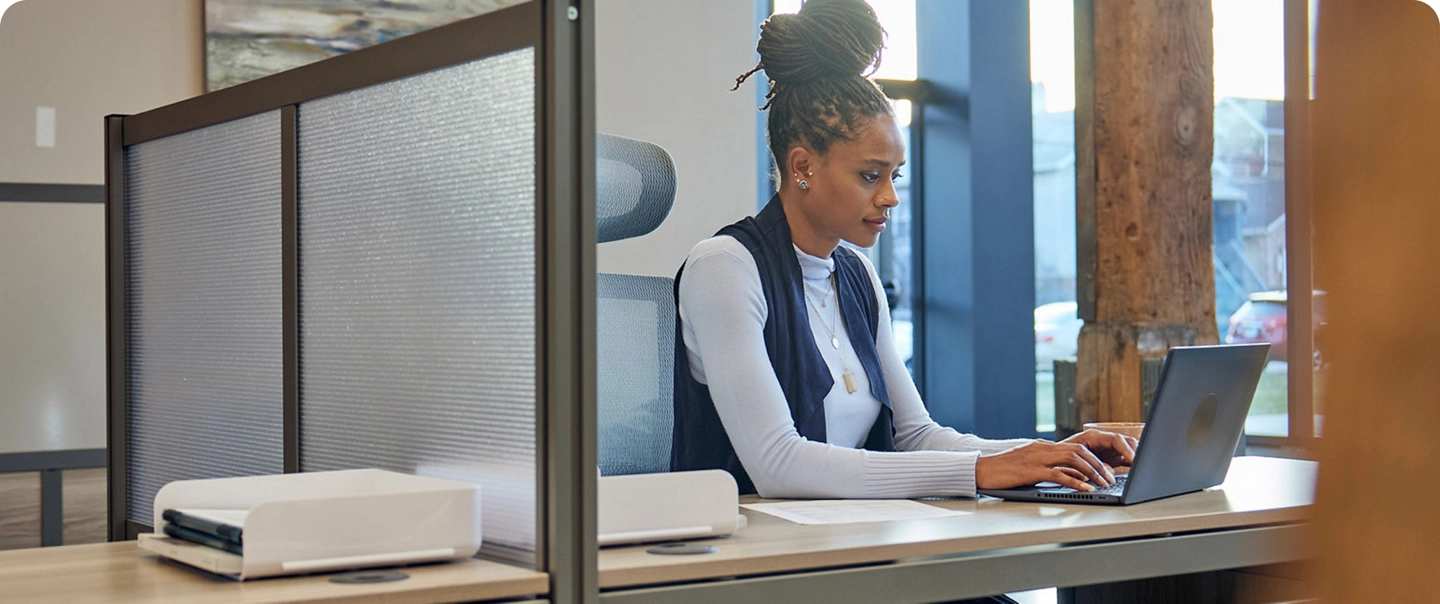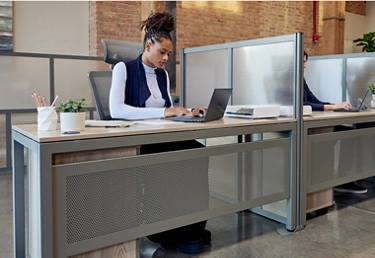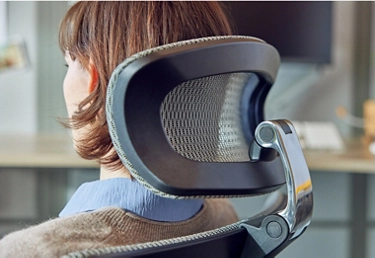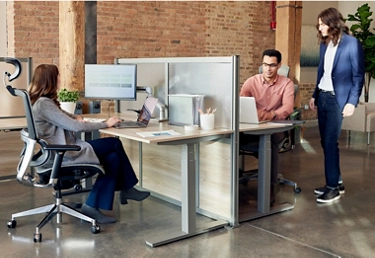Compile Quickship Custom Cubicles
Need a custom cubicle solution quickly? We got you.

Adaptable workstations help employees make the most of their in-office time. They can serve both the need for focused work and informal collaboration. Whether you’re looking for a quick-turn solution or our expert space planning and design team to provide a custom cubicle design for your space, we’re here to help.
Adaptable workstations help employees make the most of their in-office time. They can serve both the need for focused work and informal collaboration. Whether you’re looking for a quick-turn solution or our expert space planning and design team to provide a custom cubicle design for your space, we’re here to help.
Need a custom cubicle solution quickly? We got you.
Need a custom cubicle solution quickly? We got you.

Keeping workstation furniture current and flexible can put you at the forefront of growth. Elevate your workspace with designs that can adapt to your evolving needs.
Keeping workstation furniture current and flexible can put you at the forefront of growth. Elevate your workspace with designs that can adapt to your evolving needs.

Because chairs might need to fit employees of different sizes, ergonomic adjustments are key. The more comfortable employees are, the happier they’ll be.
Because chairs might need to fit employees of different sizes, ergonomic adjustments are key. The more comfortable employees are, the happier they’ll be.

It’s important to balance the needs for collaboration and focused work. Huddle rooms and mobile room dividers can help you accomplish both.
It’s important to balance the needs for collaboration and focused work. Huddle rooms and mobile room dividers can help you accomplish both.
“I couldn't find what I needed until I came across National Business Furniture and bingo — exactly what I needed and very nice as well.”
– NBF customer
“I couldn't find what I needed until I came across National Business Furniture and bingo — exactly what I needed and very nice as well.”
– NBF customer
We can make the process easier. Receive trusted guidance from our national network of 100+ experts.
We can make the process easier. Receive trusted guidance from our national network of 100+ experts.
Yes, office design significantly impacts productivity. An effective office layout enhances employee focus, collaboration and overall engagement. Factors such as natural light, ergonomic furniture, noise control and the balance between private and collaborative spaces contribute to a productive work environment.
Your workspace is your secret weapon in the quest for productivity and collaboration. Prioritizing its design and functionality can help you unlock new levels of creativity and efficiency. The best office layout to achieve next-level results is the one that fits your company culture and meets your business needs, budget and goals.
Different types of office layouts include:
Open office layouts – Promote communication and teamwork, suitable for tasks requiring frequent collaboration.
Hybrid office layouts – Combine open spaces with private areas, catering to diverse work styles and activities.
Activity-based workspaces layouts – Also known as zone office layouts, this option provides different areas for specific tasks like brainstorming, quiet work and meetings.
Cubicle office layouts – Offer privacy and reduce distractions while allowing for team collaboration in designated areas.
Designing a productive and collaborative workspace with cubicles and workstations involves balancing privacy with opportunities for interaction, ensuring ergonomic comfort and promoting an environment that supports both individual focus and team collaboration.
Here are key steps and considerations to achieve this:
Zoning – Create distinct work areas throughout your office space for quiet work, collaboration and meetings.
Flexible workstations – Use adjustable desks and mobile furniture to adapt to different types of work and serve team members’ specific needs.
Cubicles – Provide the privacy employees crave and minimize distractions with the integration of cubicles in your floor plan.
Acoustic solutions – Implement soundproofing materials to minimize noise levels.
Technology integration – Ensure seamless connectivity with sufficient power outlets and Wi-Fi coverage.
Modern workplaces that succeed are ones that find the right balance of configurations to empower their teams. Consider your business needs and prioritize the spaces you need to succeed – whether that be having distinct meeting rooms for collaboration and traditional cubicles for individual work, or an open floor plan with flexible workspaces that serve multiple purposes – and design your space from there.
Arranging cubicles and workstations for maximum productivity in an office requires a thoughtful approach that considers privacy, collaboration, comfort and environmental factors. Considerations should include:
Optimizing floor plan – Ensure an efficient flow of movement and accessibility with accurate measuring and thoughtful planning.
Creating noise barriers – Use plants or partitions to dampen sound to give employees a reprieve from excessive noise.
Incorporating breakout spaces – Provide areas for relaxation and informal meetings.
Supporting technological needs – Ensure all workstations have necessary tech access and are ergonomically set up.
By focusing on these elements, you can create a workspace that promotes productivity, collaboration and employee well-being.
Cubicles can increase productivity by providing employees with private workspaces that reduce distractions. Some of the most prominent challenges to productivity employees face when at the office are excessive noise and a lack of privacy. Cubicles can help remedy this by providing a dedicated, private space to work. Plus, the cubicle walls not only block out visual distractions, but also help mitigate noise distractions as well. All in all, cubicles allow for a focused work environment while still enabling team interaction in common areas.
To design a productive and satisfying cubicle layout, it's essential to consider several key elements that enhance both individual performance and overall workplace harmony. Here are five tips to achieve this balance and boost productivity:
Ensure adequate space – Each cubicle should be spacious enough to avoid a cramped feeling.
Incorporate ergonomic furniture – Choose ergonomic office furniture like adjustable-height chairs and desks to enhance comfort.
Facilitate natural light – Position cubicles to maximize exposure to natural light or ensure that there are windows on top of cubicle walls to facilitate natural light exposure.
Allow for personalization – Let employees personalize their spaces to boost morale.
Include quiet zones and collaborative areas – Balance individual workspaces with communal zones for team activities.
Yes, office design significantly impacts productivity. An effective office layout enhances employee focus, collaboration and overall engagement. Factors such as natural light, ergonomic furniture, noise control and the balance between private and collaborative spaces contribute to a productive work environment.
Your workspace is your secret weapon in the quest for productivity and collaboration. Prioritizing its design and functionality can help you unlock new levels of creativity and efficiency. The best office layout to achieve next-level results is the one that fits your company culture and meets your business needs, budget and goals.
Different types of office layouts include:
Open office layouts – Promote communication and teamwork, suitable for tasks requiring frequent collaboration.
Hybrid office layouts – Combine open spaces with private areas, catering to diverse work styles and activities.
Activity-based workspaces layouts – Also known as zone office layouts, this option provides different areas for specific tasks like brainstorming, quiet work and meetings.
Cubicle office layouts – Offer privacy and reduce distractions while allowing for team collaboration in designated areas.
Designing a productive and collaborative workspace with cubicles and workstations involves balancing privacy with opportunities for interaction, ensuring ergonomic comfort and promoting an environment that supports both individual focus and team collaboration.
Here are key steps and considerations to achieve this:
Zoning – Create distinct work areas throughout your office space for quiet work, collaboration and meetings.
Flexible workstations – Use adjustable desks and mobile furniture to adapt to different types of work and serve team members’ specific needs.
Cubicles – Provide the privacy employees crave and minimize distractions with the integration of cubicles in your floor plan.
Acoustic solutions – Implement soundproofing materials to minimize noise levels.
Technology integration – Ensure seamless connectivity with sufficient power outlets and Wi-Fi coverage.
Modern workplaces that succeed are ones that find the right balance of configurations to empower their teams. Consider your business needs and prioritize the spaces you need to succeed – whether that be having distinct meeting rooms for collaboration and traditional cubicles for individual work, or an open floor plan with flexible workspaces that serve multiple purposes – and design your space from there.
Arranging cubicles and workstations for maximum productivity in an office requires a thoughtful approach that considers privacy, collaboration, comfort and environmental factors. Considerations should include:
Optimizing floor plan – Ensure an efficient flow of movement and accessibility with accurate measuring and thoughtful planning.
Creating noise barriers – Use plants or partitions to dampen sound to give employees a reprieve from excessive noise.
Incorporating breakout spaces – Provide areas for relaxation and informal meetings.
Supporting technological needs – Ensure all workstations have necessary tech access and are ergonomically set up.
By focusing on these elements, you can create a workspace that promotes productivity, collaboration and employee well-being.
Cubicles can increase productivity by providing employees with private workspaces that reduce distractions. Some of the most prominent challenges to productivity employees face when at the office are excessive noise and a lack of privacy. Cubicles can help remedy this by providing a dedicated, private space to work. Plus, the cubicle walls not only block out visual distractions, but also help mitigate noise distractions as well. All in all, cubicles allow for a focused work environment while still enabling team interaction in common areas.
To design a productive and satisfying cubicle layout, it's essential to consider several key elements that enhance both individual performance and overall workplace harmony. Here are five tips to achieve this balance and boost productivity:
Ensure adequate space – Each cubicle should be spacious enough to avoid a cramped feeling.
Incorporate ergonomic furniture – Choose ergonomic office furniture like adjustable-height chairs and desks to enhance comfort.
Facilitate natural light – Position cubicles to maximize exposure to natural light or ensure that there are windows on top of cubicle walls to facilitate natural light exposure.
Allow for personalization – Let employees personalize their spaces to boost morale.
Include quiet zones and collaborative areas – Balance individual workspaces with communal zones for team activities.